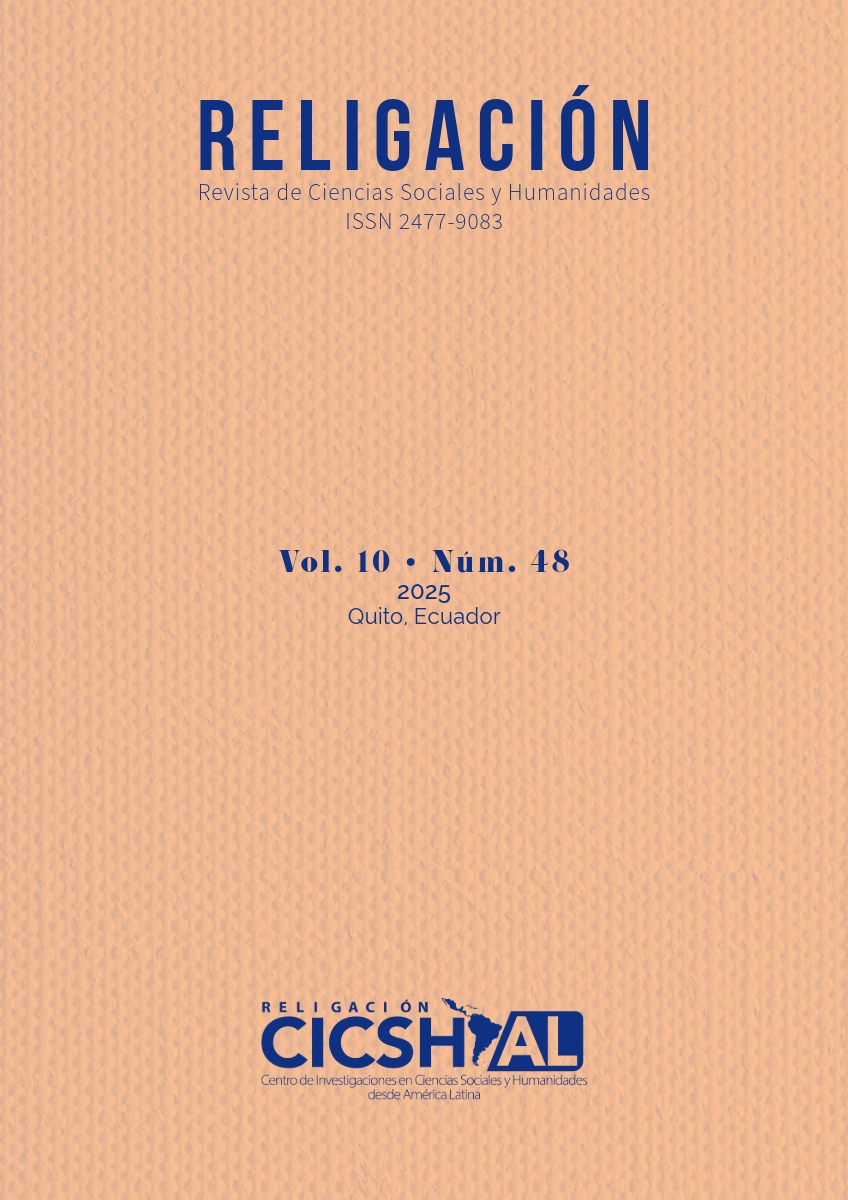Assessment of musculoskeletal symptoms and their impact on workplace ergonomics among the administrative staff of the Municipal GAD of Logroño
Abstract
This study addresses the scientific question: What are the most prevalent musculoskeletal symptoms among the administrative staff of the GAD Municipal of Logroño, and how do they influence workplace ergonomics? The general objective was to identify these symptoms and analyze their relationship with ergonomic conditions in the work environment. An observational, cross-sectional study was conducted, complemented by a literature review using scientific databases such as Scopus, SciELO, Web of Science, ScienceDirect, and Google Scholar. Data collection was carried out through a custom-designed questionnaire based on prior studies and tailored to the specific needs of this research. The analysis focused on five key variables: workload, lack of active breaks, repetitive movements, working posture, and physical effort, in relation to the presence of musculoskeletal symptoms. The results showed that workload and physical effort were the main predictors of musculoskeletal symptoms, together explaining 67.1% of their variability, while repetitive movements, working posture, and lack of active breaks had a lesser impact. These findings highlight the urgent need to prioritize ergonomic interventions aimed at reducing physical load and optimizing work organization. The study provides valuable insights for occupational health management, offering evidence to inform preventive strategies and workplace adaptations that could improve the well-being of administrative personnel. However, the small sample size (n = 29) represents a limitation, reducing the generalizability of the findings. Future research should consider larger and more diverse samples, longitudinal designs, and objective measures of physical workload to strengthen the understanding of the associations identified here. In conclusion, this research contributes meaningful evidence regarding the ergonomic challenges faced by administrative staff, underscoring the importance of targeted actions to mitigate musculoskeletal risks and enhance occupational well-being.
Downloads
Metrics
References
Comezaquira, A., Terán, G., & Quijada, P. (2021). Carga laboral y obstáculos de rendimiento del personal de enfermería en la Unidad de Cuidados Intensivos. Revista Cubana de Enfermería, 37(4).
de Araújo Vieira, E. M., da Silva, J. M. N., Leite, W. K. dos S., Lucas, R. E. C., & da Silva, L. B. (2022). Team workload and performance of healthcare workers with musculoskeletal symptoms. International Journal of Environmental Research and Public Health, 20(1). https://doi.org/10.3390/ijerph20010742
Enoka, R. M., & Duchateau, J. (2016). Translating fatigue to human performance. Medicine & Science in Sports & Exercise, 48(11), 2228–2238. https://doi.org/10.1249/MSS.0000000000000929
Girón, A., Ortiz, A., Sánchez, J., & Bermúdez, J. (2024). Percepción de la calidad de vida laboral en empleados del área de cartera de una empresa de cobranza de la ciudad de Medellín. Revista CIES, 15(2), 45-62.
Ibrahim, B. A., & Gaafar, S. E. M. (2024). Work-related musculoskeletal complaints: Risk factors and impact on work productivity among university administrative employees. Journal of the Egyptian Public Health Association, 99(1). https://doi.org/10.1186/s42506-024-00156-w
INSST. (2025). Posturas de trabajo: factores que las determinan. Riesgos derivados de las posturas de trabajo y su prevención. Instituto Nacional de Seguridad y Salud en el Trabajo.
Manrique-Collantes, R. V. (2020). Efecto de un programa de ejercicios en síntomas músculo esqueléticos en docentes de primaria. Anales de la Facultad de Medicina, 81(4), 461-468. https://doi.org/10.15381/anales.v81i4.17761
Manterola, C., Hernández, M., Otzen, T., Espinosa, M., & Grande, L. (2023). Estudios de corte transversal: Un diseño de investigación a considerar en ciencias morfológicas. International Journal of Morphology, 41(1), 364-371. https://doi.org/10.4067/S0717-95022023000100364
Mendinueta, M., Herazo, Y., Toro, L., Cetares, R., Ortiz, K., & Ricardo, Y. (2020). Riesgo por movimiento repetitivo en los miembros superiores de trabajadores: Factores personales y laborales. Archivos Venezolanos de Farmacología y Terapéutica, 39(6), 768-775.
Montoya-Torres, J., Robayo-Barrios, D., & Monroy-Caicedo, S. (2020). Evaluación de la fatiga laboral en conductores de la Cooperativa de Transporte del municipio de Planadas. IPSA Scientia, Revista Científica Multidisciplinaria, 5(1), 143–151. https://doi.org/10.25214/27114406.1006
Natali, M. B., & Barbalho-Moulim, M. C. (2021). Prevalence of musculoskeletal symptoms among administrative workers at a teaching hospital in the state of Espírito Santo, Brazil. Revista Brasileira de Medicina do Trabalho, 19(4), 465–471. https://doi.org/10.47626/1679-4435-2021-658
Noakes, T. D. (2012). Fatigue is a brain-derived emotion that regulates the exercise behavior to ensure the protection of whole body homeostasis. Frontiers in Physiology, 3. https://doi.org/10.3389/fphys.2012.00082
Organización Mundial de la Salud. (2021, 08 de febrero). Trastornos musculoesqueléticos. https://n9.cl/aqby7
Parra, M. F., González, R., Ñiripil, N., & Guzmán, E. (2024). Efecto de pausas activas en la disminución de trastornos musculoesqueléticos de extremidades superiores en oficinistas. Revista de la Asociación Española de Especialistas en Medicina del Trabajo, 33(2), 96-108. https://doi.org/10.53238/P2727_33-2_2024_07
Pincay, M., Chiriboga, G., & Vega, V. (2021). Posturas inadecuadas y su incidencia en trastornos músculo esqueléticos. Revista de la Asociación Española de Especialistas en Medicina del Trabajo, 30(2), 161-168. https://doi.org/10.53238/P2727_30-2_2021_11
Ramos-Galarza, C. A. (2020). Alcances de una investigación. CienciAmérica, 9(3), 1–6. https://doi.org/10.33210/ca.v9i3.336
Ruiz Barrios, A. S., Becerra del Llano, M. F., Islas Muñoz, V. L., Hernández Valle, V., García Medina, N. E., & Girón Solís, P. T. (2022). Identificación del nivel de riesgo ergonómico por manejo de cargas y movimientos repetitivos en industria alimentaria. Lux Médica, 17(51), 45-53. https://doi.org/10.33064/51lm20223507
Shahwan, B., D’emeh, W., & Yacoub, M. (2022). Evaluation of computer workstations ergonomics and its relationship with reported musculoskeletal and visual symptoms among university employees in Jordan. International Journal of Occupational Medicine and Environmental Health, 35(2), 141–156. https://doi.org/10.13075/ijomeh.1896.01822
Tunja, D., Achote, M., & Montero, Y. (2021). El estrés laboral y la necesidad de pausas activas en la Federación Deportiva de Cotopaxi. En A. Hermosa, (ed.). Perspectivas para un siglo cambiante en las organizaciones y el turismo de siglo XXI (pp. 61-93). UISRAEL.
Verástegui, B., & Vales, J. (2021). Carga laboral docente en tiempos de pandemia, factor de estrés y su impacto en la enseñanza remota. Revista Iberoamericana de Educación, 85(1), 1-17. https://doi.org/10.35362/rie8514669
Copyright (c) 2025 Nicole Andrea Delgado Mendoza, Patricio Esteban Mendieta Andrade

This work is licensed under a Creative Commons Attribution-NonCommercial-NoDerivatives 4.0 International License.











